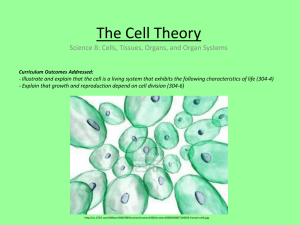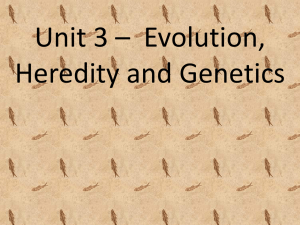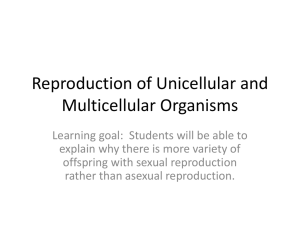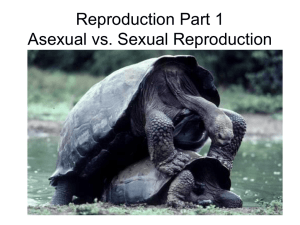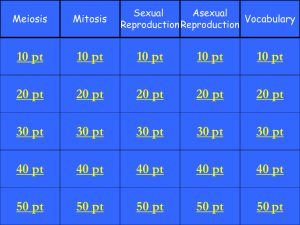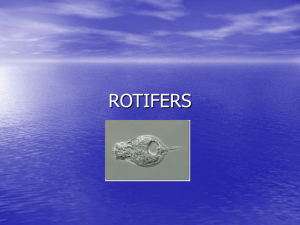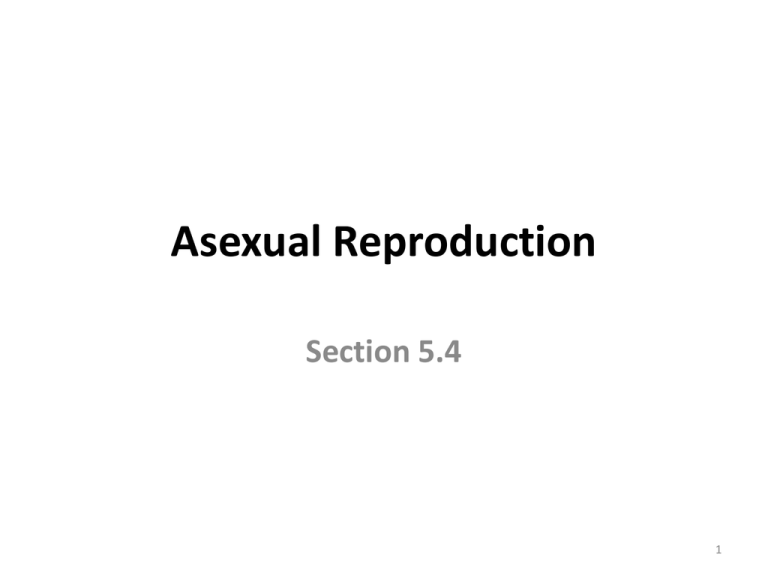
Asexual Reproduction
Section 5.4
1
Objectives
• SWBAT compare and contrast binary fission
and mitosis.
• SWBAT describe how eukaryotes reproduce
through mitosis.
2
Vocabulary
•
•
•
•
Asexual reproduction
Budding
Fragmentation
Binary fission
3
Question to Contemplate
• What is asexual reproduction?
4
Reproduction
• Reproduction – process that makes new
organisms from one or more parent
organisms.
– Sexual reproduction – involves the joining of two
specialized, haploid, cells called gametes.
• Gametes are egg and sperm cells.
– Asexual reproduction – the creation of offspring
from a single parent – it involves no gametes and
the offspring are genetically identical to the
parent.
5
Binary Fission
Most prokaryotes (remember, no
nucleus) reproduce through binary
fission. At right is the last stage of
binary fission in an amoeba. Above is
binary fission in a paramecium.
6
Binary Fission
• Binary Fission – the asexual reproduction of a
single-celled organism by division into 2
roughly equal parts.
– binary fission and mitosis are have similar results.
Both processes form two genetically identical
daughter cells.
– Bacteria and other prokaryotes have one “ringshaped” chromosome in the cytoplasm, no
nucleus, and no spindle fibers.
7
Binary Fission
• Binary fission starts when the chromosome
ring is copied.
– The two rings are attached to the cell membrane.
– As the cell grows and elongates, the chromosomes
move away from each other.
– When the cell is 2X its original size, it undergoes
cytokinesis.
• Cleavage takes place, new cell membrane is laid down
between the 2 identical daughter cells.
8
Binary Fission
parent cell
DNA
duplicates
cell begins
to divide
daughter
cells
9
Advantages to Asexual Reproduction
• In stable environments, asexual reproduction can be
very effective and efficient – more so than sexual
reproduction.
• In stable environments, genetic
variation could be unnecessary or
even a drawback (if you are perfectly
suited for an environment, why
would you want change?).
• Asexual reproduction allows for very
rapid reproduction and can be a
competitive advantage over sexual
reproduction.
10
Advantages to Asexual Reproduction
• All of the individuals of an asexually
reproducing population can reproduce.
• In a sexually reproducing population roughly
half the population (this is highly dependent
on the species) does not produce offspring.
11
Disadvantages to Asexual
Reproduction
• Genetically identical offspring will respond to the
environment in the same way.
– This is a problem if the environment is not stable and
the genetically identical population is not able to
cope.
– In unstable environments, the genetic diversity that
can come from sexual reproduction is important to
helping an organism to adapt.
– Species that reproduce asexually always are capable
of reproducing sexually (by conjugation in bacteria).
– Sexual reproduction is more costly to organisms – and
slower (not as efficient).
12
Conjugation in bacteria
Bacteria swapping DNA
13
Sexual Reproduction
• Sexually reproducing organisms must attract a
mate.
– This takes time and energy – it is a significant cost.
– There is also a lot of structures (the plumes of a
quetzal or peacock, antlers on a deer, etc.),
signals, and behaviors that have evolved for
attracting and picking mates.
– Asexual reproduction does not come with these
costs.
14
15
Plasmid Integration
16
Some eukaryotes reproduce through mitosis –
Ex 1. Budding
Budding is when a small
projection of tissue grows on
the surface of the parent –
eventually becoming a new
individual. Growth is through
mitosis – there is no
recombination.
Hydra
bud
The new individual may live
independently (like the hydra
will) or as part of a colony like
yeast.
Yeast
17
Reproduction through Fragmentation
Parent organism splits into pieces, each of which grows, through mitosis,
into a new individual.
18
Vegetative Reproduction
Plants are masters of asexual
reproduction. Vegetative
reproduction is when a new
individual develops through the
modification of the original
organism’s tissues (for example,
the modification of roots or
stems).
Prairie grasses, strawberries,
potatoes, and many, many other
species can reproduce this way.
19


